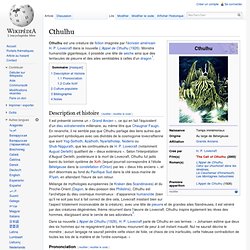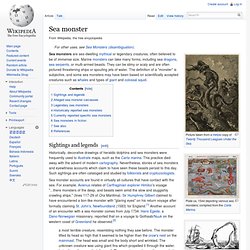

Underwater picture gallery. Cretoxyrhina - Sea Monsters: A Prehistoric Adventure Movie Photo Gallery. "Pancake" Sea Slug Among New Philippines Species. Hard-to-See Sea Creatures Revealed. Photos: Dragonfish, Fireworm, More Found by Sea Surveys. Créatures des profondeurs - part1. Les animaux extraordinaires des profondeurs. Endless Oceans: Monsters of the Deep!
Voyage Dans Les Profondeurs de l'Ocean 1/4. Odd-Looking Marine Animals. "QUANTUM SHOT" #449link 10 creatures, each one step short of an alien life form You've seen some weird marine creatures in our previous articles "Out-of-this-world Fishing" and "Big Fish Extravaganza".

Now we present more, and probably the weirdest bunch yet. Article is based on material from Chan Lee Peng, written by Avi Abrams. They exist. 1. Whatever you do, don't put it in your salad. (image credit: Jeffrey N. (image credit: Namisan) A leafy sea dragon (phycodurus eques) has long leaf-like protrusions all over its body, serving as camouflage among different types of floating seaweeds or kelp beds. (image credit: Steve) It's found along the coastline of Australia; a fully grown leafy sea dragon can reach about 45cm (18in).
(image credit: James D. A most distinguished portrait, worthy to be framed: (image credit: nas-city) 2. Here is a creature from the underwater gates of hell. (image credit: Bruce Robison) (images credit: John Kealy and captbluefin) 3. This squid sees the world in color. 4. Awesome Octopi: Cephalopods from Outer Space. "QUANTUM SHOT" #530Link - by Avi Abrams Nothing's like an octopus that wants to hide.

Pun intended: it does look like nothing until you approach really close, then it springs at you (morphs at you, intimidates and astounds you, you pick the right verb) Here is a video that most tellingly shows how some unassuming clump of weed on a rock can grow tentacles in a matter of moments: Big Fish Extravaganza. Fishing can be DANGEROUS (art credit: Monica Langlois) But seriously, some people catch really big fish, and spread even bigger tales about it.

Source China Daily. Dwellers In The Abyss: Ugly, Monstrous Fish. "QUANTUM SHOT" #648Link - article by M.

Christian and A. Abrams "Why are the Earth's oceans more mysterious to us than the Moon? " Odd-Looking Marine Animals. Out-of-This-World Fishing. "QUANTUM SHOT" #410link Also Read Part 1 What lurked in the depths, now is going to haunt your boat.

Be careful what you hook up. Aside from picking some vicious industrial garbage, you can bring to the surface some strange and unmentionable things. Most fishermen will happily brag about an extraordinary big fish (and we'll show plenty of those in this article). "Larger than life" (but hopefully still real) catches We all know that the size of our largest catch is only limited to how wide we can stretch our arms, and how gullible your friends are. (a whale shark, not that big either) Catfish the size of a small car? Mythe de Cthulhu. Un article de Wikipédia, l'encyclopédie libre. Le Mythe de Cthulhu (Cthulhu Mythos en anglais) est un univers de fiction issu des nouvelles et romans de l'écrivain américain H. P. Lovecraft. Le monde du Mythe est le monde réel, mais des forces obscures et surhumaines, aussi puissantes qu'anciennes, y cherchent à rétablir leur ancienne domination sur l'humanité.
L'une d'entre elles est Cthulhu, qui apparaît dans la nouvelle L'Appel de Cthulhu (1928) et dont August Derleth a repris le nom pour désigner l'ensemble du Mythe. Cthulhu. Un article de Wikipédia, l'encyclopédie libre.

Description et histoire[modifier | modifier le code] Monstre marin. Sea monster. Sea monsters are sea-dwelling mythical or legendary creatures, often believed to be of immense size.

Marine monsters can take many forms, including sea dragons, sea serpents, or multi-armed beasts. They can be slimy or scaly and are often pictured threatening ships or spouting jets of water. The definition of a "monster" is subjective, and some sea monsters may have been based on scientifically accepted creatures such as whales and types of giant and colossal squid. Sightings and legends[edit] Plate ca. 1544 depicting various sea monsters; compiled from the Carta Marina. Historically, decorative drawings of heraldic dolphins and sea monsters were frequently used to illustrate maps, such as the Carta marina. Sea serpent reported by Hans Egede, Bishop of Greenland, in 1734. Sea monster accounts are found in virtually all cultures that have contact with the sea.
A most terrible creature, resembling nothing they saw before. David Gallo nous fait découvrir des merveilles sous-marines. Monstres & animaux des profondeur - Une playlist. Vidéo Creatures Rares dans les Abysses de lenore62 (Musique - lenore62. Portail:Biologie marine. What Lives in the Sea Image Gallery. Strange Science: Sea Monsters. Contrary to popular belief, the sailors of Columbus's day did not think they would sail right off the edge of the earth.

They were, however, apprehensive about what they would find in their travels. Mistakes about marine life have ranged from inaccurate assumptions about the behavior of known species to fanciful depictions of animals that "might" exist. Most Recent Additions. Encountering Sea Monsters - Introduction - Octopus, squid, and other cephalopods. NATURE’s Encountering Sea Monsters follows Bob Cranston in his quest to film and understand the world’s most mysterious cephalopods.

Imagine coming face to face with a cannibalistic creature that is as tall as you are and has long tentacles, a razor-sharp beak, and skin that flashes with bizarre, dazzling color. NATURE’s Encountering Sea Monsters does just that, as underwater cameraman Bob Cranston explores the remarkable world of marine creatures called cephalopods.
Cephalopods include squids, cuttlefish, octopi, and nautili. Cranston and top marine scientists dive in waters from Indonesia and Mexico to Australia and Texas, meeting up with a variety of cephalopods — from the tiny but deadly blue-ringed octopus to the giant Humboldt squid, known for its aggressive behavior, flashing light shows, and cannibalism. A Decade of Discovery.